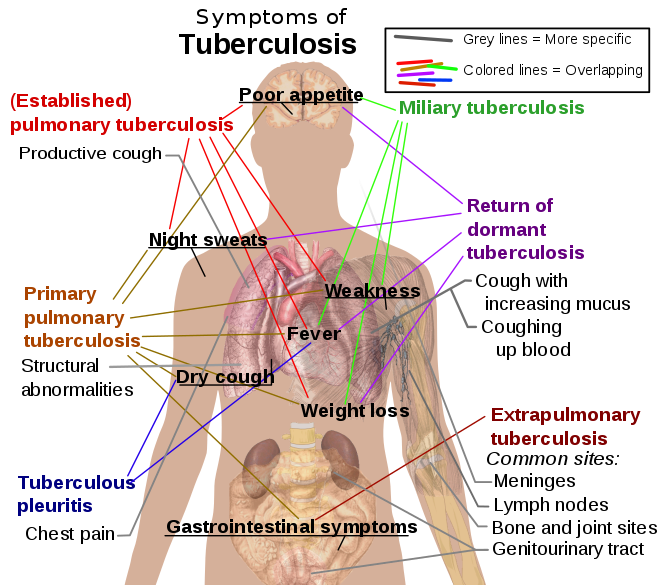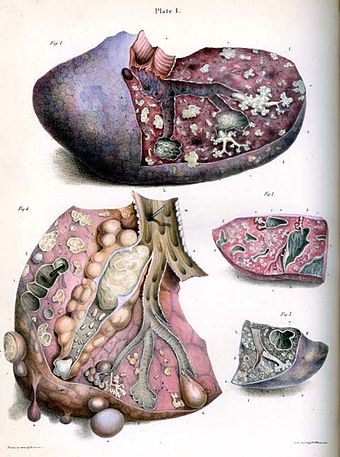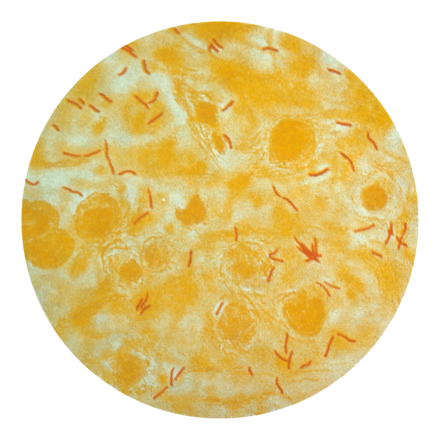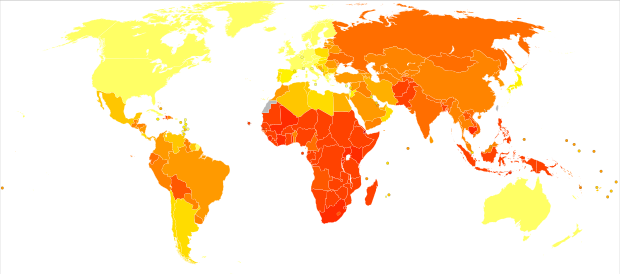Tuberculosis
Tuberculosis (TB) is an infectious disease caused by the bacterium Mycobacterium tuberculosis (MTB). It primarily affects the lungs but can impact other body parts.
TB is highly infectious, spreading through the air when individuals with active TB cough, sneeze, or speak. Latent TB, which shows no symptoms, can become active in about 10% of cases.

Signs and Symptoms
TB symptoms vary but commonly include a chronic cough with blood-containing mucus, fever, night sweats, and weight loss. Pulmonary TB affects the lungs, causing chest pain and prolonged cough producing sputum.
Extrapulmonary TB, occurring outside the lungs, is more common in immunocompromised individuals and can affect the pleura, central nervous system, lymphatic system, genitourinary system, and bones.

Causes and Risk Factors
TB is caused by the Mycobacterium tuberculosis complex, which includes M. bovis, M.
africanum, and others. Risk factors for TB include HIV/AIDS, smoking, diabetes, malnutrition, and immunosuppressive medications.

Pathogenesis
Upon inhalation, TB bacteria reach the alveolar sacs of the lungs, where they replicate within macrophages. The immune response involves forming granulomas to contain the infection, but the bacteria can become dormant, leading to latent TB.
Active disease arises when the immune system fails to contain the bacteria, causing tissue destruction and necrosis.

Diagnosis
Diagnosing TB involves chest X-rays, sputum cultures, and skin or blood tests. The Mantoux tuberculin skin test and Interferon-gamma release assays (IGRAs) are used for latent TB detection.
For active TB, the identification of M. tuberculosis in clinical samples is definitive.

Prevention
TB prevention includes vaccination with the Bacillus Calmette-Guérin (BCG) vaccine, especially in children, and screening high-risk individuals. Public health measures, such as avoiding overcrowding and improving sanitation, also help reduce TB transmission.

Treatment
TB treatment requires long-term antibiotic use, typically involving a combination of drugs like rifampicin, isoniazid, pyrazinamide, and ethambutol. Treatment duration is usually six months but may extend to 18-24 months for multidrug-resistant TB (MDR-TB).
Directly observed therapy (DOT) ensures patients adhere to their medication regimen. Surgery may be necessary in severe or drug-resistant cases.

Epidemiology
TB remains a global health issue, with a significant burden in South-East Asia, Africa, and the Western Pacific. In 2022, 10.6 million people developed active TB, resulting in 1.3 million deaths.
Factors such as poverty, overcrowding, and malnutrition exacerbate TB's impact in developing regions.

Self-assessment MCQs (single best answer)
What is the primary cause of Tuberculosis (TB)?
Which of the following is NOT a common symptom of active pulmonary TB?
Which diagnostic test is typically used for identifying latent TB infection?
What is the main mode of transmission for Tuberculosis?
Which vaccine is primarily used to prevent Tuberculosis?
Which of the following is a major risk factor for developing active TB?
What is the standard initial treatment regimen for new-onset pulmonary TB?
Which of the following is a common site for extrapulmonary TB?
What is the most significant complication associated with the treatment of multidrug-resistant TB (MDR-TB)?
Which of the following measures is very important in preventing the spread of TB?
Dentaljuce
Dentaljuce provides Enhanced Continuing Professional Development (CPD) with GDC-approved Certificates for dental professionals worldwide.
Founded in 2009 by the award-winning Masters team from the School of Dentistry at the University of Birmingham, Dentaljuce has established itself as the leading platform for online CPD.
With over 100 high-quality online courses available for a single annual membership fee, Dentaljuce offers comprehensive e-learning designed for busy dental professionals.
The courses cover a complete range of topics, from clinical skills to patient communication, and are suitable for dentists, nurses, hygienists, therapists, students, and practice managers.
Dentaljuce features Dr. Aiden, a dentally trained AI-powered personal tutor available 24/7 to assist with queries and provide guidance through complex topics, enhancing the learning experience.
Check out our range of courses, or sign up now!


